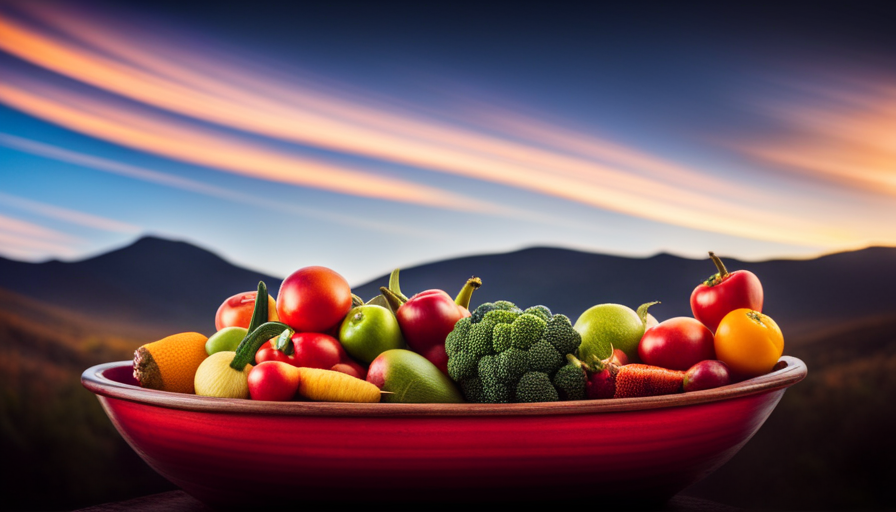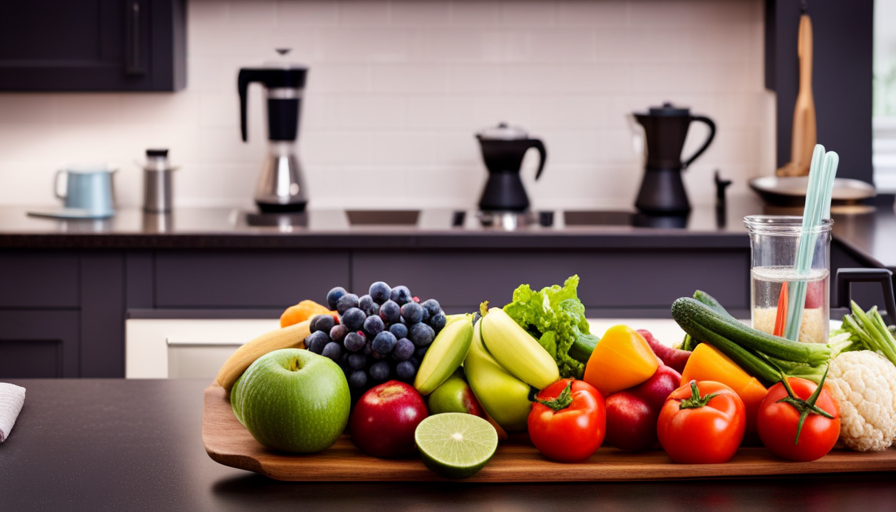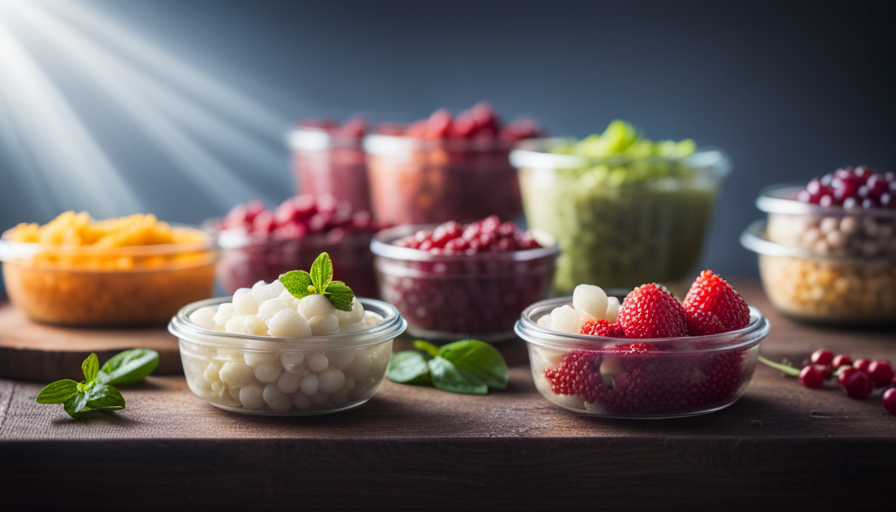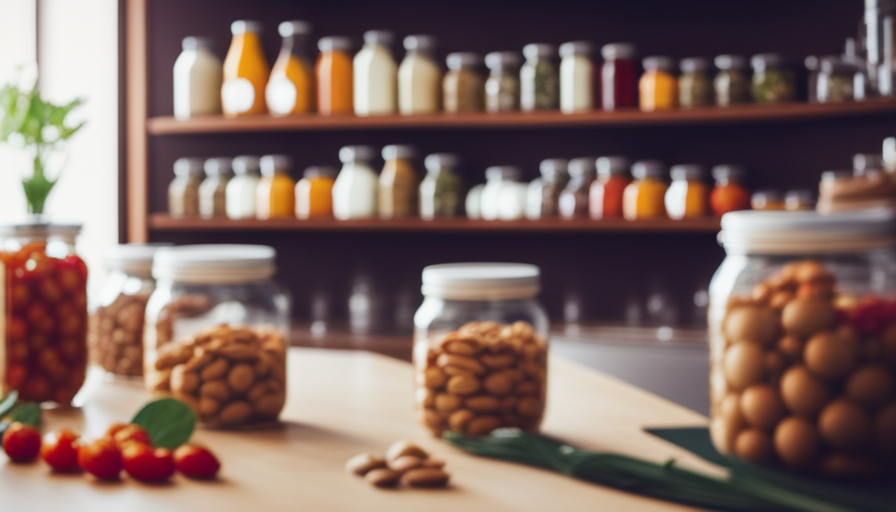Are you looking to improve your health and well-being?
One theory suggests that increasing your raw food intake can have numerous benefits. Raw foods are packed with essential nutrients, enzymes, and antioxidants that can boost your immune system, improve digestion, and increase energy levels.
But how can you incorporate more raw foods into your diet?
In this article, we will explore practical and evidence-based strategies to help you increase your raw food intake. From transitioning to a raw food diet to incorporating more fresh fruits and vegetables, we will provide you with actionable steps to make this lifestyle change.
We will also delve into raw food preparation techniques, snacks, desserts, smoothies, and juices that will add variety and flavor to your meals.
Additionally, we will discuss the importance of finding support and inspiration to stay consistent on your raw food journey.
Get ready to transform your health with the power of raw foods!
Key Takeaways
- Gradually transition and experiment with recipes to increase raw food intake.
- Stock up on raw fruits and vegetables to make it easier to choose raw options.
- Incorporate fresh fruits and vegetables into every meal to increase raw food intake.
- Experiment with flavors, textures, and raw food preparation techniques to enjoy raw foods.
Understanding the Benefits of Raw Foods
If you want to boost your health and energy levels, you need to understand why eating raw foods is a game-changer for your well-being! By understanding the nutritional value and advantages of raw food, you can make informed choices that will benefit your body.
Raw foods are packed with essential nutrients that are often lost during cooking. Heat can destroy certain vitamins and enzymes, but by consuming raw foods, you ensure that you’re getting the maximum nutritional benefit.
Raw fruits and vegetables are rich in vitamins, minerals, and antioxidants that are crucial for maintaining a strong immune system and preventing chronic diseases.
Another advantage of raw food is its high fiber content. Fiber aids digestion, helps to regulate blood sugar levels, and keeps you feeling full for longer. This can be especially helpful if you’re trying to maintain a healthy weight.
Additionally, raw foods are often lower in calories and fat compared to their cooked counterparts. This can be beneficial for weight loss or weight management. Raw food also tends to be more hydrating, as it contains water that is lost during the cooking process.
Incorporating more raw foods into your diet can be as simple as adding a side salad to your meals or snacking on raw fruits and vegetables. By doing so, you’ll be providing your body with the nutrients it needs to thrive and enjoy optimal health and energy levels.
Transitioning to a Raw Food Diet
Although it may seem difficult at first, incorporating more uncooked fruits and vegetables into your daily meals can be a simple and enjoyable process. Transitioning to a raw food diet requires some planning and preparation, but with the right tips and knowledge, you can make the shift smoothly. Here are some transitioning tips to help you increase your raw food intake:
-
Gradual Transition: Start by incorporating raw fruits and vegetables into your existing meals. Replace cooked sides with raw salads or add raw toppings to your cooked dishes.
-
Experiment with Recipes: Explore raw food recipes and try new dishes. This will keep your meals exciting and help you discover new flavors and textures.
-
Stock Up on Raw Foods: Make sure to have a variety of raw fruits and vegetables readily available at home. This will make it easier to choose raw options when you’re hungry.
-
Overcoming Challenges: Common challenges when transitioning to a raw food diet include cravings for cooked foods and social pressures. Stay motivated by reminding yourself of the health benefits and seek support from like-minded individuals or online communities.
Remember, transitioning to a raw food diet is a personal journey, and it’s important to listen to your body’s needs. Take it at your own pace and enjoy the process of exploring new and nutritious raw food options.
Incorporating More Fresh Fruits and Vegetables
To add more fresh fruits and vegetables to your diet, try experimenting with vibrant and colorful produce options that’ll bring a burst of flavor and nutrients to your plate.
When it comes to fresh produce shopping tips, it’s important to choose fruits and vegetables that’re in season, as they tend to be more flavorful and affordable. Look for local farmer’s markets or community-supported agriculture programs for the freshest options. Additionally, consider buying organic produce to avoid pesticides and chemicals.
Raw food meal planning can be made easier by incorporating fruits and vegetables into every meal. Start your day with a refreshing fruit salad or a green smoothie packed with leafy greens like spinach or kale.
For lunch, opt for a large salad filled with various raw vegetables and topped with a homemade dressing. Snack on raw carrots, celery, or cucumber slices throughout the day. And for dinner, try a raw zucchini pasta with a fresh tomato sauce or a colorful stir-fry with a mix of raw and lightly cooked vegetables.
Remember, the key to increasing your raw food intake is to make it enjoyable and sustainable. Experiment with different flavors and textures, and don’t be afraid to try new fruits and vegetables. By incorporating more fresh produce into your meals and following these tips, you’ll be well on your way to increasing your raw food intake and reaping the benefits of a healthier lifestyle.
Exploring Raw Food Preparation Techniques
Get creative in the kitchen and discover a world of exciting raw food preparation techniques that’ll leave your taste buds dancing like a symphony. Raw food doesn’t have to be boring or bland; there are numerous ways to make it visually appealing and delicious. Here are some raw food presentation ideas and garnishing techniques to elevate your raw food game:
-
Fruit and Vegetable Carpaccio: Thinly slice a variety of colorful fruits and vegetables and arrange them in an overlapping pattern on a plate. You can use a mandolin slicer for precision. Garnish with a drizzle of olive oil, a sprinkle of sea salt, and some freshly chopped herbs for added flavor.
-
Spiralized Salads: Invest in a spiralizer to create beautiful vegetable noodles. Mix different types of spiralized vegetables like zucchini, cucumber, and beetroot for a vibrant and crunchy salad. Top it off with a tangy dressing and some toasted nuts for extra texture.
-
Edible Flower Arrangements: Add a touch of elegance to your raw food dishes by incorporating edible flowers. They not only enhance the visual appeal but also provide a delicate floral flavor. Popular options include pansies, nasturtiums, and violets.
With these raw food presentation ideas and garnishing techniques, you can turn a simple raw dish into a work of art that’s as pleasing to the eyes as it is to the palate. So go ahead, get creative, and enjoy the beauty and nourishment of raw food.
Trying Raw Food Snacks and Desserts
Indulge in a delectable array of raw food snacks and desserts that’ll satisfy your cravings and leave you feeling guilt-free and energized.
Raw food snacks and desserts are not only delicious but also packed with nutrients, as they’re made from unprocessed, whole ingredients. By incorporating these raw treats into your diet, you can increase your intake of raw foods and reap their numerous health benefits.
Raw food snacks can be as simple as sliced fruits and vegetables, or you can get creative and make energy balls or bars using nuts, seeds, and dried fruits. These snacks provide a quick and convenient way to boost your raw food consumption, whether you’re at home or on the go. They’re also rich in fiber, vitamins, and minerals, promoting digestion and overall well-being.
When it comes to raw food desserts, there are endless options to satisfy your sweet tooth. From raw fruit tarts and pies to creamy avocado chocolate mousse, these desserts are not only delicious but also guilt-free. Raw desserts are typically made with natural sweeteners like dates or maple syrup, avoiding refined sugars and artificial additives. They’re also often gluten-free and dairy-free, making them suitable for various dietary preferences.
Incorporating raw food snacks and desserts into your diet is a simple and enjoyable way to increase your raw food intake. By choosing these nutritious treats, you can indulge in delicious flavors while nourishing your body with wholesome, unprocessed ingredients. So go ahead, try out some raw food snacks and desserts, and enjoy the benefits they bring to your health and well-being.
Incorporating Raw Nuts and Seeds into Your Meals
When it comes to incorporating raw nuts and seeds into your meals, you’ll discover a whole new world of flavor and texture that’ll elevate your dishes to a whole new level.
Not only do raw nuts and seeds add a delicious crunch to your meals, but they also provide a great source of protein and healthy fats.
Here are three creative ways to incorporate nuts and seeds into your meals:
-
Sprinkle them on top: Whether you’re making a salad, stir-fry, or even a bowl of oatmeal, adding a handful of raw nuts or seeds on top can instantly enhance the taste and texture of your dish. Try sprinkling almonds on your salad or adding pumpkin seeds to your morning oatmeal.
-
Blend them into sauces: You can create creamy and flavorful sauces by blending raw nuts and seeds with herbs, spices, and a bit of water. For example, blend cashews with garlic, lemon juice, and nutritional yeast to make a delicious dairy-free ‘cheese’ sauce.
-
Use them as a crust: Crushed raw nuts and seeds can make a tasty and nutritious crust for baked goods or savory dishes. Try using crushed walnuts or almonds as a crust for baked chicken or fish, or use a mixture of seeds as a crust for homemade energy bars.
By incorporating raw nuts and seeds into your meals, you not only increase your raw food intake but also add a nutritious and flavorful element to your dishes. So, get creative and start experimenting with these versatile ingredients today!
Experimenting with Raw Food Smoothies and Juices
Discover the incredible benefits of experimenting with raw food smoothies and juices by incorporating them into your daily routine. Raw food smoothies are a fantastic way to increase your intake of fruits and vegetables while enjoying a refreshing and nutritious drink. By blending raw fruits and vegetables, you’re able to retain all the vitamins, minerals, and enzymes that are often lost during cooking. This means you’re getting the maximum nutritional value from your ingredients.
When experimenting with raw food smoothies, the possibilities are endless. You can mix and match different fruits and vegetables to create unique flavor combinations. For example, try blending spinach, banana, and pineapple for a delicious and nutrient-packed green smoothie. Or, mix berries, almond milk, and a handful of kale for a tasty and antioxidant-rich treat.
Raw food smoothies aren’t just delicious, but they also provide numerous health benefits. They’re a great source of fiber, which can aid in digestion and promote a healthy gut. Additionally, they’re packed with antioxidants, which help protect your body against free radicals and oxidative stress.
Incorporating raw food smoothies into your daily routine is a simple and convenient way to increase your raw food intake. Whether you have them for breakfast, as a snack, or as a post-workout refresher, these smoothies are sure to leave you feeling energized and nourished. So, grab your blender and start experimenting with different combinations today!
Enhancing Flavor with Raw Herbs and Spices
Savor the sensational taste of raw herbs and spices as you sprinkle them into your smoothies and juices, adding a zesty zing to your sips. Enhancing the flavor of your raw food creations can make them even more enjoyable and satisfying. Experimenting with different combinations of herbs and spices allows you to discover new and exciting flavor profiles.
To enhance the flavor of your smoothies and juices, consider the following combinations:
- Citrusy Delight: Add a squeeze of fresh lemon or lime to your green smoothie for a burst of tanginess.
- Spicy Kick: Sprinkle a pinch of cayenne pepper or ginger into your fruit smoothie to add a spicy kick.
- Herbal Infusion: Blend in a handful of fresh herbs like mint, basil, or cilantro to infuse your smoothie with a refreshing herbal taste.
By adding these raw herbs and spices, you not only enhance the flavor, but also benefit from their nutritional properties. For example, ginger has anti-inflammatory properties, while mint aids digestion.
Don’t be afraid to get creative and experiment with different combinations. You may discover a new favorite flavor that excites your taste buds and keeps you motivated to increase your raw food intake. So go ahead, sprinkle, blend, and enjoy the deliciousness of raw herbs and spices in your smoothies and juices!
Staying Consistent with Your Raw Food Journey
To stay consistent with your raw food journey, it’s important to find creative ways to incorporate raw herbs and spices into your daily meals. Maintaining motivation and overcoming challenges are key to staying on track.
Raw herbs and spices not only enhance the flavor of your meals but also provide numerous health benefits. One way to maintain motivation is by experimenting with different herbs and spices. This can keep your meals interesting and prevent boredom. Try adding fresh basil and oregano to your salads, or sprinkle some cinnamon and nutmeg on your raw fruit desserts. The variety will keep you excited about your raw food journey.
However, it’s important to be aware of the challenges that may arise. One common challenge is finding time to prepare raw meals. To overcome this, you can pre-cut your herbs and spices in advance or consider using dried herbs and spices as a convenient option. Another challenge is the temptation to indulge in processed foods. To combat this, remind yourself of the benefits of raw food and the progress you’ve made so far.
By staying motivated and finding ways to overcome challenges, you can successfully increase your raw food intake and enjoy the health benefits that come with it. Incorporating raw herbs and spices into your daily meals is a simple yet effective way to enhance the flavor and make your raw food journey enjoyable.
Finding Support and Inspiration for Your Raw Food Lifestyle
Now that you’ve learned about the importance of staying consistent with your raw food journey, let’s explore how you can find support and inspiration to help you along the way.
One of the best ways to stay motivated and connected with others who share your passion for raw food is by finding online resources and joining raw food communities.
The internet is a treasure trove of information when it comes to raw food. There are numerous websites, blogs, and social media platforms dedicated to sharing recipes, tips, and success stories. These resources can provide you with a wealth of knowledge and inspiration, as well as a sense of community. You can access a wide range of recipes, meal plans, and even online courses to deepen your understanding of raw food.
In addition to online resources, joining raw food communities can be incredibly beneficial. These communities often consist of like-minded individuals who are on a similar journey. They provide a space for you to connect, share experiences, ask questions, and receive support. Whether it’s through online forums, social media groups, or local meetups, these communities can offer a sense of belonging and encouragement.
By utilizing online resources and joining raw food communities, you can find the support and inspiration needed to stay motivated on your raw food journey. Remember, you don’t have to do it alone – there are countless others out there who are ready to cheer you on and share their wisdom.
Frequently Asked Questions
How do I properly wash fruits and vegetables before consuming them raw?
To properly wash fruits and vegetables before consuming them raw, start by rinsing them under cold running water. Use a vegetable brush to scrub firm produce like potatoes or carrots. Avoid using soap or detergent, as they can leave a residue.
Organic produce is important as it’s grown without synthetic pesticides or fertilizers. Washing your produce thoroughly helps remove dirt, bacteria, and any pesticide residue, promoting food safety and better health.
Are there any potential risks or side effects associated with a raw food diet?
Potential risks and side effects may be associated with a raw food diet. One concern is nutrient deficiencies, as certain nutrients like vitamin B12, iron, and omega-3 fatty acids are more easily obtained from cooked foods.
Additionally, raw foods can carry harmful bacteria and parasites, increasing the risk of foodborne illnesses.
It’s important to ensure a balanced and varied diet that includes a mix of raw and cooked foods to minimize these potential risks and maintain optimal health.
Can I still get enough protein on a raw food diet?
You can definitely get enough protein on a raw food diet by incorporating various raw food protein sources. Foods like nuts, seeds, and legumes are rich in protein and can be enjoyed in their raw form.
Additionally, leafy greens and certain vegetables also contain small amounts of protein.
A raw food diet offers numerous benefits, including increased nutrient intake, improved digestion, and enhanced energy levels. So, you can confidently meet your protein needs while enjoying the benefits of a raw food diet.
Are there any specific food combinations I should avoid when eating raw?
To enhance nutrient absorption, be mindful of specific food combinations when eating raw. Avoid pairing foods that hinder digestion, like fruits and grains, which can cause bloating and discomfort. Instead, focus on combining foods that complement each other, such as leafy greens with citrus fruits.
Additionally, incorporate more raw foods into your meals by adding a variety of colorful vegetables to salads, blending fruits into smoothies, and snacking on raw nuts and seeds throughout the day.
Can I eat cooked foods occasionally while following a raw food diet?
Yes, you can occasionally eat cooked foods while following a raw food diet. However, it’s important to focus on incorporating more raw food alternatives into your meals to maximize the benefits of a raw food diet. Raw foods are rich in nutrients, enzymes, and antioxidants that can support your overall health. By gradually increasing your raw food intake and finding creative ways to include more raw options in your meals, you can reap the benefits of both raw and cooked foods.
How Does a Raw Food Diet Affect the pH of Water?
A raw food diet can increase water pH naturally due to its alkalizing effect on the body. This vegan diet consists of raw fruits and vegetables that are rich in alkaline minerals, which can help balance the body’s pH levels and lead to more alkaline water.
Conclusion
So there you have it, you’ve reached the end of this article on how to increase your raw food intake. Hopefully, you’ve learned a thing or two about the benefits of raw foods and how to transition to a raw food diet.
It’s important to incorporate more fresh fruits and vegetables into your meals and explore different raw food preparation techniques. Don’t forget to try out some delicious raw food snacks and desserts!
And remember, staying consistent with your raw food journey is key. Good luck on your ironic quest to embrace the raw food lifestyle!










